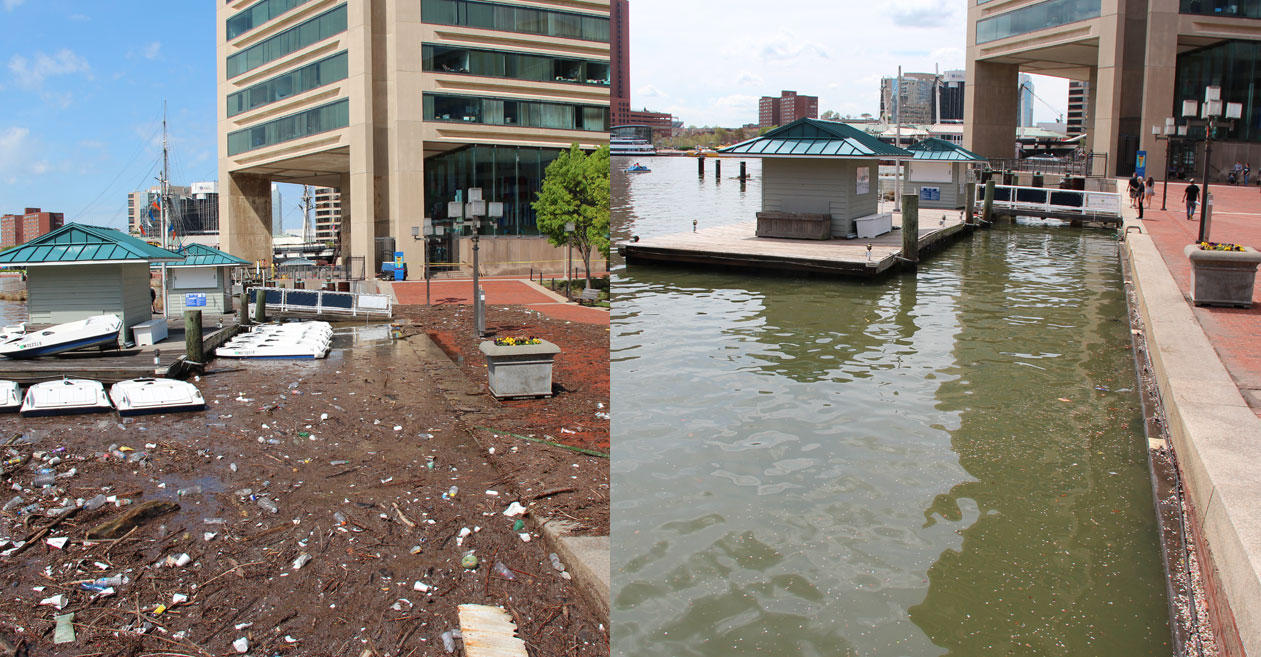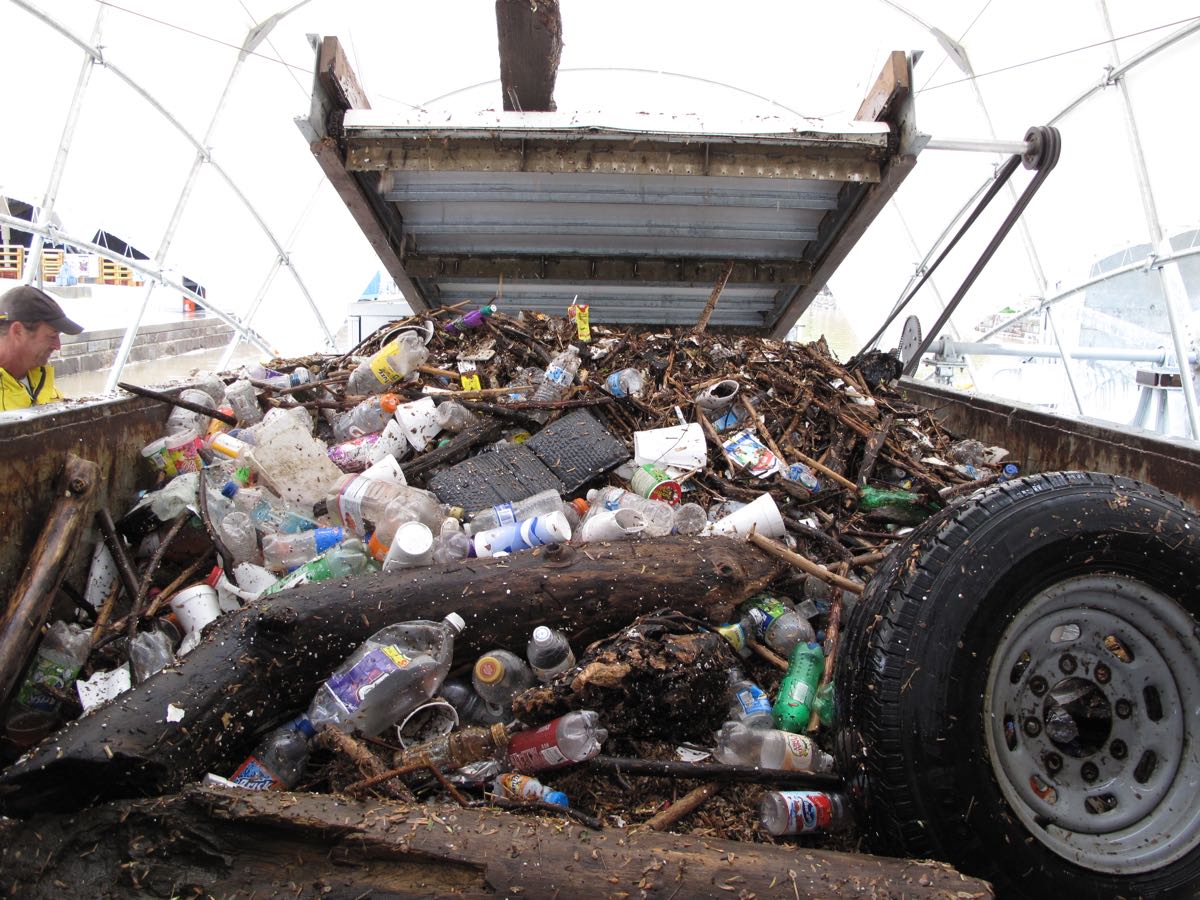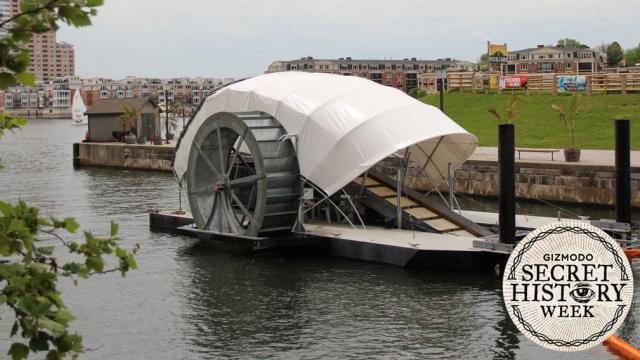If a friend told you he was off to take a dip in Baltimore’s Harbour, you’d probably be concerned for his health and sanity. But five years from now, swimming in Baltimore’s waterways might not sound so crazy — and there’s an innovative piece of technology to thank.
Meet the Water Wheel: A hydro and solar-powered barge that’s been parked in Baltimore’s Inner Harbour since 2014, slurping up any and all garbage that makes its way downriver. To date, the device has skimmed 100,000 grocery bags, 200,000 plastic bottles, nearly 300,000 styrofoam cups, and over six million cigarette butts out of the water.
In total, Baltimore’s Water Wheel has picked up some 350 tonnes of trash — using nothing but the current and the sun.
Impressive as this sounds, the Water Wheel is but a small part of a much larger effort to improve the environment of a city that’s sick of being portrayed as a post-industrial garbage heap. “I think it’s wonderful that this positive change can come out of Baltimore, a city that’s been depicted pretty negatively by the media,” Adam Lindquist, director of the Healthy Harbour initiative at the Waterfront Partnership of Baltimore.
“I really believe we can become a global model for restoring the environments of waterfronts.”
The Call for Cleaner Rivers
Like many colonial American cities, Baltimore’s got some seriously ancient infrastructure, and that’s led to a host of environmental problems. Take the septic system. In theory, separate storm drains and sewer pipes should keep Baltimore’s wastewater out of its rivers. But many of the city’s century-old pipes are leaky and failing. Every time a major storm hits, literal shit and trash spills out of the sewers and into the Patapsco River, a tributary of Maryland’s Chesapeake Bay.
Baltimore is under a consent decree with the EPA to repair the failing sewer system. But with limited funds to do so, progress has been slow. In the meanwhile, trash continues to blight the Inner Harbour, a tourism hub that’s home to the Camden Yards Baseball Stadium and the Baltimore Aquarium. For the past two years, Baltimore’s own “Healthy Harbour Report Card” has given the watershed an “F,” with bacteria from sewage and storm runoff making the water unsafe to touch, let alone wade in.

Left: The Baltimore harbour in April 2014, following a torrential downpour. Right: The same harbour this past April. Image Credt: Waterfront Partnership of Baltimore / Adam Lindquist
Historic ship manager John Kellett is among the many Baltimore residents who was sick of watching garbage cruise down rivers every time it rained. His solution — a giant, floating wheel that turns with the current of the river, sucking trash in on a conveyor belt — drew inspiration from the cotton mills that lined Baltimore’s Jones Falls River during colonial times. In 2008, Kellett built and deployed his first prototype “trash wheel.” During its eight months spinning on the Jones River, the device attracted the attention of Baltimore’s Waterfront Partnership, who joined forces with Kellett to raise money for a more permanent installation. In 2014, the city’s official trash-collecting Water Wheel launched onto the Inner Harbour.

The Water Wheel. Image Credit: Waterfront Partnership of Baltimore / Adam Lindquist
Unlike Kellet’s original design, Baltimore’s Water Wheel gets a portion of its power from the sun. According to Lindquist, solar panels ensure that the wheel has continuous access to power in Baltimore’s tidal waterways. “In the rain, there’s plenty of current to keep the wheels turning,” Lindquist told Gizmodo. “But when it’s not raining, sometimes the water flows backwards, and we needed another source of power.”
So far, Baltimore’s Water Wheel — known to locals as “Mr. Trash Wheel” — has been a roaring success, skimming thousands of pounds of floating junk out of the harbour every day. After collection, the trash is deposited into a dumpster barge and towed to a nearby waste-to-energy plant, where it’s converted to electricity and fed into the city’s grid.

Inside the Water Wheel. Image Credit: Waterfront Partnership of Baltimore / Adam Lindquist
Thanks to social media, the Water Wheel’s accomplishments have been broadcast far beyond Baltimore’s Inner Harbour. Its YouTube videos have garnered millions of hits, and a recent AMA landed the Water Wheel at the top of Reddit’s front page. Among the wheel’s admirers are planners and developers looking for inexpensive ways to clean up their own rivers.
Boom – @MrTrashWheel just beat @Starwars to be #1 on @Reddit (yes I just referred to myself in the 3rd person) pic.twitter.com/m4KsO4DHKZ
— Mr. Trash Wheel (@MrTrashWheel) October 20, 2015
“Public love of the device has been tremendous,” Lindquist said. “Now, we get calls from cities around the world, from Rio to Indonesia, looking to adapt this technology.”
Recycled Islands and Oyster Farms
Baltimore’s Water Wheel is certainly a notable environmental success story. But in Lindquist’s view, it’s a small part of a much bigger clean up effort, one that dovetails with restoration work taking place throughout Maryland’s Chesapeake Bay region.
“We’re looking at the Water Wheel as a short-term solution,” Lindquist said. “The trash is unacceptable, and this is a simple way to stop the flow of it.” Through concurrent education and outreach initiatives and legislation to ban plastic bags, Baltimore is attempting to tackle its trash problem at the roots. Over the longer term, infrastructure improvements, similar to those implemented in Copenhagen over a decade ago, should prevent wastewater from being discharged into the harbour during heavy rainfall.
Garbage aside, water quality is another big issue throughout the Chesapeake Bay. To reduce turbidity and pollution levels, the city recently kicked off a Floating Wetlands initiative. “Islands” consisting of native wetland plants kept buoyant by recycled trash suck up nutrient pollution and replenish oxygen. To date, 185 square metres of wetlands have been installed in the Inner Harbour, providing habitat for herons, otters, and other animals that haven’t been seen in decades.
Meanwhile, the Great Baltimore Oyster Partnership is repopulating waterways with another natural filtration agent. Centuries ago, enough oysters lived in the Chesapeake Bay to filter its entire volume every three days; their population has since been decimated by pollution and overexploitation. The city has already introduced over 200,000 baby oysters and is aiming to plant 5 million throughout the Patapsco by 2020.
It may be some years before locals are swimming in Baltimore’s waters and visitors are eating oysters collected alongside the docks. But that’s the long-term vision. “Any urban water body isn’t going to be swimmable 100% of the time,” Lindquist said. “Our goal is to get to a point by 2020 where we can start advertising what days it is safe to go into the water.”
And if Baltimore can even imagine such a future, that should offer hope to many cities around the world.
